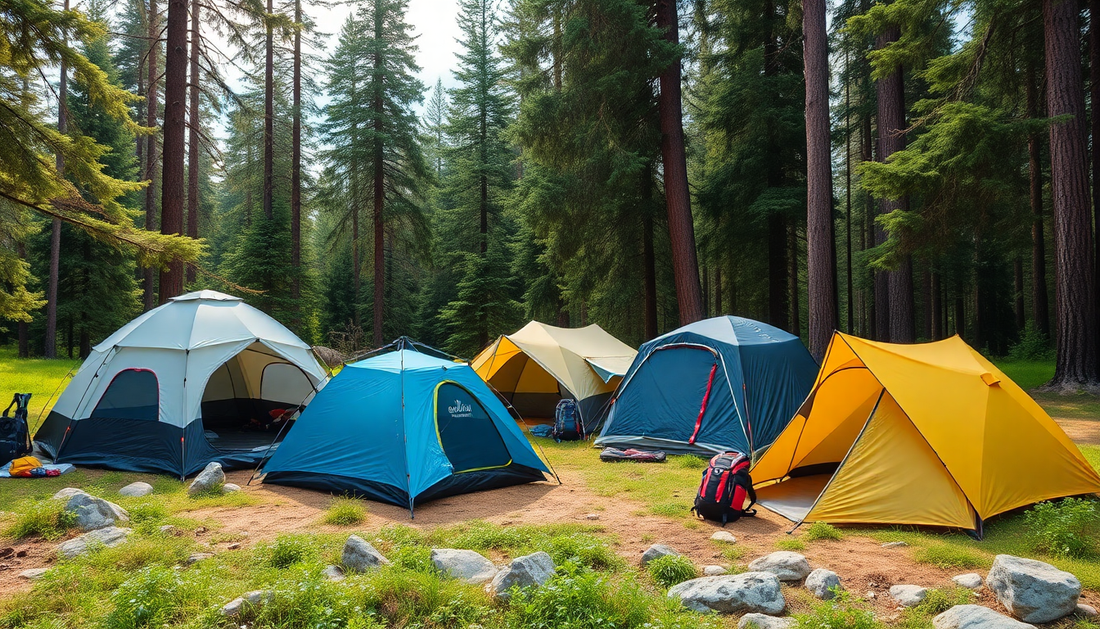
How to Choose the Best Camping Shelter: A Complete Guide for Every Outdoor Adventure
Share
Discover the secrets to selecting the perfect camping shelter for your next outdoor excursion. Whether you're an avid backpacker, a casual camper, or an adventurer seeking to explore the great outdoors, choosing the right shelter is crucial for a comfortable and successful trip. At CampInMeeIhie, we're here to guide you through the process of finding the best camping shelter to suit your needs.
Types of Camping Shelters
When it comes to camping shelters, there's a wide range of options to consider. From the classic tent to the versatile tarp, each type of shelter offers its own unique benefits and drawbacks. Let's explore the most common camping shelter choices:

Tents
Tents are the quintessential camping shelter, providing a cozy and enclosed space to rest and protect you from the elements. They come in a variety of sizes, shapes, and designs to accommodate solo adventurers, couples, or larger groups.
Hammocks
Hammocks offer a lightweight and comfortable alternative to traditional ground-based shelters. They're perfect for camping in forested areas, allowing you to sleep suspended above the ground.
Tarps
Tarps are a versatile and budget-friendly option, offering protection from rain, wind, and sun. They can be set up in a variety of configurations, making them a great choice for minimalist campers or those seeking a more open-air experience.
Bivy Sacks
Bivy sacks are compact, single-person shelters that provide a lightweight and streamlined solution for solo backpackers. They offer basic protection from the elements while maintaining a small footprint.
Cabin-Style Shelters
For those seeking a more substantial and spacious camping experience, cabin-style shelters, such as yurts or canvas wall tents, provide a more luxurious and comfortable option.
Key Factors in Choosing a Camping Shelter
When selecting the best camping shelter for your needs, there are several key factors to consider:
Weather Resistance
Ensuring your shelter can withstand the elements, such as rain, wind, and snow, is crucial for a comfortable and safe camping experience. Look for features like waterproofing, sturdy construction, and adequate ventilation.
Size and Capacity
Choose a shelter that can comfortably accommodate the number of people in your group, as well as any gear or equipment you'll be bringing along.
Weight and Portability
If you'll be backpacking or hiking to your campsite, weight and portability are essential considerations. Opt for a lightweight and compact shelter that won't weigh you down.
Ease of Setup
Look for shelters that are easy to assemble, especially if you'll be setting up and taking down camp frequently.
Season Rating
Consider the time of year and the expected weather conditions when selecting a shelter. Some shelters are designed for specific seasons, such as three-season or four-season tents.
Matching Shelters to Camping Environments
The type of camping environment you'll be exploring can also influence your choice of shelter. Let's take a look at some recommendations for different terrains:
Mountainous Terrain
For high-altitude or exposed mountain camping, choose a sturdy, four-season tent with excellent wind and weather resistance.
Forest Camping
In forested areas, a lightweight tarp or hammock setup can be an excellent choice, allowing you to take advantage of the natural surroundings.
Beach/Coastal Areas
In coastal regions, seek out shelters with strong waterproofing and UV protection to withstand the elements.
Desert Camping
For desert camping, look for shelters with good ventilation and sun protection to keep you cool and comfortable.
Winter Conditions
When camping in cold weather, insulated, four-season tents or cabin-style shelters can provide the necessary warmth and protection.
Budget Considerations
Camping shelters can range widely in price, from entry-level options to premium, high-end models. Consider your budget and the level of investment you're willing to make, keeping in mind that higher-quality shelters often provide better durability and performance.
Entry-Level Shelters
For those on a tighter budget, there are many affordable, basic tents and tarps that can still offer reliable protection.
Mid-Range Shelters
In the mid-range, you'll find well-made, feature-rich shelters that strike a balance between cost and quality.
Premium Camping Shelters
At the higher end of the spectrum, premium camping shelters often boast advanced materials, innovative designs, and exceptional weather resistance, making them a wise investment for serious outdoor enthusiasts.
Essential Features to Look For
When evaluating potential camping shelters, keep an eye out for these essential features:
Waterproofing
Ensure the shelter's fabric and seams are waterproof to keep you dry in wet conditions.
Ventilation
Proper ventilation is crucial for regulating temperature and preventing condensation buildup inside the shelter.
Material Durability
Choose a shelter made from high-quality, long-lasting materials that can withstand the rigors of outdoor use.
Insulation
For cold-weather camping, look for shelters with built-in insulation or the ability to accommodate additional insulation layers.
Additional Storage
Features like vestibules, pockets, and gear lofts can provide valuable extra storage space for your belongings.
Maintenance and Care Tips
To ensure your camping shelter lasts for many adventures, proper maintenance and care are essential. Follow these tips:
Cleaning Techniques
Regularly clean your shelter using a mild soap and water, and allow it to fully dry before storing.
Storage Recommendations
When not in use, store your shelter in a cool, dry place, and avoid compressing it for extended periods.
Repair and Longevity
Address any minor tears or damage promptly to maintain the shelter's integrity and extend its lifespan.

Conclusion
Choosing the best camping shelter for your outdoor adventures is a crucial decision that can make or break your experience. By considering the various shelter types, key selection factors, and the specific needs of your camping environment, you can find the perfect shelter to keep you comfortable, protected, and ready to explore the great outdoors. Remember, investing in a quality camping shelter is an investment in your future adventures. Happy camping!
